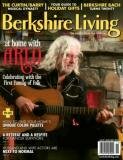
ART REVIEW: Modernism and post-modernism at the Berkshire Museum
Pittsfield, Mass.
Ven Voisey: Artifact
Nancy Graves: Journey to North Africa
Joe Wheaton and Susan Rodgers: Spatial Relationships
Review by Tresca Weinstein
Overheard at the Berkshire Museum recently: "I just activated a talking bear in there—it's from one extreme to the other at this museum."
That's for sure. The art and artifacts in the museum's current and permanent collections run the gamut from father-and-son mummies Pahat and Shep-en-Min, on view in the family-friendly Wrapped, to minimalist steel sculpture in Joe Wheaton and Susan Rodgers' Spatial Relationships, to large-scale two-dimensional works by American artists ranging from Thomas Moran to Gregory Crewdson.
As for Talking Animal (Yellow Bear speaks for Spare Change), it's one of half a dozen pieces by North Adams-based artist Ven Voisey on view through August 29 in the museum's new Wider Window gallery. Essentially two hallways connected by an industrial-style staircase, the gallery is a fitting backdrop for Voisey's technology-based installations, including A Sign for the Sound of Everything At Once, a collection of lightbulbs that visually "murmur" when approached, and The Story of Folds, in which five seventies-style televisions broadcast changing line drawings showing the spatial adventures of a bevy of folding chairs. It's fun to watch while listening to the odd squawks, static, clattering and droning transmitted through the old-fashioned telephone receiver in The Amplification of Wisdom.
Wisdom of a sort is also spouted by the bear, a ragtag burlap toy with a cassette tape embedded in his abdomen who, when his box is fed with a coin, speaks like a cross between a New-Age seeker and a Match.com ad.
In the adjoining gallery, work by Pittsfield native Nancy Graves (1939-1995), inspired by her 1970 trip to North Africa, is on view through October 31. Graves' father was assistant director of the Berkshire  Museum during her childhood, and it's easy to draw lines from the pieces on display here—including curling organic shapes in bronze reminiscent of Joseph Beuys' work—to the natural history she was surrounded with growing up. (You can find similar organic objects in a permanent display here devoted to animal scat.)
Museum during her childhood, and it's easy to draw lines from the pieces on display here—including curling organic shapes in bronze reminiscent of Joseph Beuys' work—to the natural history she was surrounded with growing up. (You can find similar organic objects in a permanent display here devoted to animal scat.)
Graves was not only the first woman to receive a solo retrospective at the Whitney Museum, she was reportedly also the first artist to pioneer video installations like Izy Boukir, which follows a caravan of camels in Morocco, as well as so-called "scatter sculpture." One example is her Inside-Outside, in which replicas of camel skin and bones, meticulously formed from steel, oil paint, wax, marble dust, acrylic, and fiberglas, are scattered across the floor. Though impressive as recreations, they are less visually captivating than Graves' simple, evocative bronze sculptures, Shadow Six Legs (at left) and Split; half-elegant, half-menacing, they balance on long, spindly legs like abstracted insects.
On view through October 11, the work of Joe Wheaton and Susan Rodgers, old friends and Berkshire County residents, comfortably shares space in one of the larger galleries. Mediums rub up against each other in Rodger's work: wooden sticks are caught fast in narrow steel cages in Night Sounds (below); thick ropes wrap around a metal framework; and lengths of aluminum tubing bend like waving grasses in their wooden base. There's a lovely Rothko-esque serenity to her Remains of the Day, a collection of seventeen aluminum and wire panels in burnished shades of purple, turquoise, green, and copper.
Wheaton, meanwhile, is all over the map—looping curlicues of steel mounted on the wall project both weight and exuberance; steel sculptures resemble medieval tools; and piles of bubble-gum-pink eraser dust are joined with all manner of materials, including rocks, plastic dolls, tin cans, chicken feet, and moss. Don't even try to "get it"—just check it out.
Tresca Weinstein is a contributing editor to Berkshire Living and BerkshireLive's art critic.

 Delicious
Delicious Digg
Digg StumbleUpon
StumbleUpon Propeller
Propeller Reddit
Reddit Magnoliacom
Magnoliacom Newsvine
Newsvine Technorati
Technorati
